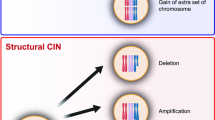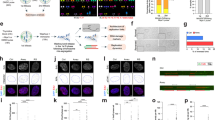Abstract
Cancer chromosomal instability (CIN) results in an increased rate of change of chromosome number and structure and generates intratumour heterogeneity1,2. CIN is observed in most solid tumours and is associated with both poor prognosis and drug resistance3,4. Understanding a mechanistic basis for CIN is therefore paramount. Here we find evidence for impaired replication fork progression and increased DNA replication stress in CIN+ colorectal cancer (CRC) cells relative to CIN− CRC cells, with structural chromosome abnormalities precipitating chromosome missegregation in mitosis. We identify three new CIN-suppressor genes (PIGN (also known as MCD4), MEX3C (RKHD2) and ZNF516 (KIAA0222)) encoded on chromosome 18q that are subject to frequent copy number loss in CIN+CRC. Chromosome 18q loss was temporally associated with aneuploidy onset at the adenoma–carcinoma transition. CIN-suppressor gene silencing leads to DNA replication stress, structural chromosome abnormalities and chromosome missegregation. Supplementing cells with nucleosides, to alleviate replication-associated damage5, reduces the frequency of chromosome segregation errors after CIN-suppressor gene silencing, and attenuates segregation errors and DNA damage in CIN+ cells. These data implicate a central role for replication stress in the generation of structural and numerical CIN, which may inform new therapeutic approaches to limit intratumour heterogeneity.
This is a preview of subscription content, access via your institution
Access options
Subscribe to this journal
Receive 51 print issues and online access
$199.00 per year
only $3.90 per issue
Buy this article
- Purchase on Springer Link
- Instant access to full article PDF
Prices may be subject to local taxes which are calculated during checkout




Similar content being viewed by others
References
Gerlinger, M. et al. Intratumor heterogeneity and branched evolution revealed by multiregion sequencing. N. Engl. J. Med. 366, 883–892 (2012)
Ding, L. et al. Clonal evolution in relapsed acute myeloid leukaemia revealed by whole-genome sequencing. Nature 481, 506–510 (2012)
Lengauer, C., Kinzler, K. W. & Vogelstein, B. Genetic instabilities in human cancers. Nature 396, 643–649 (1998)
McGranahan, N., Burrell, R. A., Endesfelder, D., Novelli, M. R. & Swanton, C. Cancer chromosomal instability: therapeutic and diagnostic challenges. EMBO Rep. 13, 528–538 (2012)
Bester, A. C. et al. Nucleotide deficiency promotes genomic instability in early stages of cancer development. Cell 145, 435–446 (2011)
Thompson, S. L. & Compton, D. A. Chromosomes and cancer cells. Chromosome Res. 19, 433–444 (2011)
Janssen, A., van der Burg, M., Szuhai, K., Kops, G. J. & Medema, R. H. Chromosome segregation errors as a cause of DNA damage and structural chromosome aberrations. Science 333, 1895–1898 (2011)
Crasta, K. et al. DNA breaks and chromosome pulverization from errors in mitosis. Nature 482, 53–58 (2012)
Pampalona, J., Soler, D., Genesca, A. & Tusell, L. Whole chromosome loss is promoted by telomere dysfunction in primary cells. Genes Chromosom. Cancer 49, 368–378 (2010)
Ichijima, Y. et al. DNA lesions induced by replication stress trigger mitotic aberration and tetraploidy development. PLoS ONE 5, e8821 (2010)
Thompson, S. L. & Compton, D. A. Examining the link between chromosomal instability and aneuploidy in human cells. J. Cell Biol. 180, 665–672 (2008)
Gisselsson, D. Classification of chromosome segregation errors in cancer. Chromosoma 117, 511–519 (2008)
Bartkova, J. et al. DNA damage response as a candidate anti-cancer barrier in early human tumorigenesis. Nature 434, 864–870 (2005)
Tort, F. et al. Retinoblastoma pathway defects show differential ability to activate the constitutive DNA damage response in human tumorigenesis. Cancer Res 66, 10258–10263 (2006)
Lukas, C. et al. 53BP1 nuclear bodies form around DNA lesions generated by mitotic transmission of chromosomes under replication stress. Nature Cell Biol. 13, 243–253 (2011)
Chan, K. L., Palmai-Pallag, T., Ying, S. & Hickson, I. D. Replication stress induces sister-chromatid bridging at fragile site loci in mitosis. Nature Cell Biol. 11, 753–760 (2009)
Kawabata, T. et al. Stalled fork rescue via dormant replication origins in unchallenged S phase promotes proper chromosome segregation and tumor suppression. Mol. Cell 41, 543–553 (2011)
Harrigan, J. A. et al. Replication stress induces 53BP1-containing OPT domains in G1 cells. J. Cell Biol. 193, 97–108 (2011)
Cancer Genome Atlas Research Network. Comprehensive molecular characterization of human colon and rectal cancer. Nature 487, 330–337 (2012)
Bunz, F. et al. Targeted inactivation of p53 in human cells does not result in aneuploidy. Cancer Res. 62, 1129–1133 (2002)
Halazonetis, T. D., Gorgoulis, V. G. & Bartek, J. An oncogene-induced DNA damage model for cancer development. Science 319, 1352–1355 (2008)
Rowan, A. et al. Refining molecular analysis in the pathways of colorectal carcinogenesis. Clin. Gastroenterol. Hepatol. 3, 1115–1123 (2005)
Pasello, G. et al. DNA copy number alterations correlate with survival of esophageal adenocarcinoma patients. Mod. Pathol. 22, 58–65 (2009)
Yatsuoka, T. et al. Association of poor prognosis with loss of 12q, 17p, and 18q, and concordant loss of 6q/17p and 12q/18q in human pancreatic ductal adenocarcinoma. Am. J. Gastroenterol. 95, 2080–2085 (2000)
Sigoillot, F. D. et al. A bioinformatics method identifies prominent off-targeted transcripts in RNAi screens. Nature Methods 9, 363–366 (2012)
Dereli-Oz, A., Versini, G. & Halazonetis, T. D. Studies of genomic copy number changes in human cancers reveal signatures of DNA replication stress. Mol. Oncol. 5, 308–314 (2011)
Chan, K. L. & Hickson, I. D. On the origins of ultra-fine anaphase bridges. Cell Cycle 8, 3065–3066 (2009)
Lee, A. J. et al. Chromosomal instability confers intrinsic multidrug resistance. Cancer Res. 71, 1858–1870 (2011)
Cesare, A. J. et al. Spontaneous occurrence of telomeric DNA damage response in the absence of chromosome fusions. Nature Struct. Mol. Biol. 16, 1244–1251 (2009)
Groth, P. et al. Methylated DNA causes a physical block to replication forks independently of damage signalling, O6-methylguanine or DNA single-strand breaks and results in DNA damage. J. Mol. Biol. 402, 70–82 (2010)
Greenman, C. D. et al. PICNIC: an algorithm to predict absolute allelic copy number variation with microarray cancer data. Biostatistics 11, 164–175 (2010)
Popova, T. et al. Genome Alteration Print (GAP): a tool to visualize and mine complex cancer genomic profiles obtained by SNP arrays. Genome Biol. 10, R128 (2009)
Chin, S. F. et al. High-resolution aCGH and expression profiling identifies a novel genomic subtype of ER negative breast cancer. Genome Biol. 8, R215 (2007)
Benjamini, Y. & Hochberg, Y. Controlling the false discovery rate: a practical and powerful approach to multiple testing. J. Stat. Soc. 57, 289–300 (1995)
Beroukhim, R. et al. Assessing the significance of chromosomal aberrations in cancer: methodology and application to glioma. Proc Natl Acad Sci USA 104, 20007–20012 (2007)
Storey, J. D. & Siegmund, D. Approximate P-values for local sequence alignments: numerical studies. J. Comput. Biol. 8, 549–556 (2001)
Durinck, S. et al. BioMart and Bioconductor: a powerful link between biological databases and microarray data analysis. Bioinformatics 21, 3439–3440 (2005)
Thirlwell, C. et al. Clonality assessment and clonal ordering of individual neoplastic crypts shows polyclonality of colorectal adenomas. Gastroenterology 138, 1441–1454 (2010)
Leedham, S. J. et al. Clonality, founder mutations, and field cancerization in human ulcerative colitis-associated neoplasia. Gastroenterology 136, 542–550 (2009)
Acknowledgements
We thank A. Straube for reagents. C.S. is a senior Medical Research Council clinical research fellow and is funded by Cancer Research UK, the Medical Research Council, EU FP7 (projects PREDICT and RESPONSIFY), Prostate Cancer Foundation, and the Breast Cancer Research Foundation. We thank A. Futreal and The Wellcome Trust Sanger Centre and The Cancer Genome Atlas Research Network for providing genomics data. I.P.T. is supported by the Oxford Biomedical Research Centre and Cancer Research UK. J.B. is funded by the Danish Cancer Society, the Lundbeck Foundation, and the European Commission (FP7 projects DDResponse, Biomedreg and Infla-Care). T.H. is funded by the Swedish Cancer Society, the Swedish Research Council and the Torsten and Ragnar Söderberg Foundation.
Author information
Authors and Affiliations
Contributions
C.S., R.A.B., S.E.M., J.B. and T.H. devised experiments. R.A.B. and S.E.M. performed most cell biological experiments with help from N.S., S.K.C., E.G., S.M.D., A.J.R. and N.K. D.E., A.S. and M.S. performed bioinformatics analysis supervised by M.K. P.G., M.-C.W. and T.H. performed and analysed the DNA fibre assays. E.D. and I.P.T. provided the adenoma-in-carcinoma cohort and CGH for aneuploid tumours. M.H. and A.B. provided experimental advice. C.S. supervised all aspects of the project. C.S., R.A.B., S.E.M., I.P.T. and J.B. wrote the paper. All authors discussed results and approved the manuscript.
Corresponding author
Ethics declarations
Competing interests
The authors declare no competing financial interests.
Supplementary information
Supplementary Information
This file contains Supplementary Figures 1-14; Supplementary Tables 1, 4, 6 and 7; legends for Supplementary Tables 2, 3 and 5; Supplementary References and a Supplementary Sweave document. (PDF 5025 kb)
Supplementary Data
This file contains Supplementary Tables 2, 3 and 5 – see Supplementary Information file for details. (XLS 401 kb)
Rights and permissions
About this article
Cite this article
Burrell, R., McClelland, S., Endesfelder, D. et al. Replication stress links structural and numerical cancer chromosomal instability. Nature 494, 492–496 (2013). https://doi.org/10.1038/nature11935
Received:
Accepted:
Published:
Issue Date:
DOI: https://doi.org/10.1038/nature11935
This article is cited by
-
MYCT1 inhibits hematopoiesis in diffuse large B-cell lymphoma by suppressing RUNX1 transcription
Cellular & Molecular Biology Letters (2024)
-
Oncogenic c-Myc induces replication stress by increasing cohesins chromatin occupancy in a CTCF-dependent manner
Nature Communications (2024)
-
The heterogeneity and clonal evolution analysis of the advanced prostate cancer with castration resistance
Journal of Translational Medicine (2023)
-
Identification of DNA damage response-related genes as biomarkers for castration-resistant prostate cancer
Scientific Reports (2023)
-
Tracking the evolution of esophageal squamous cell carcinoma under dynamic immune selection by multi-omics sequencing
Nature Communications (2023)
Comments
By submitting a comment you agree to abide by our Terms and Community Guidelines. If you find something abusive or that does not comply with our terms or guidelines please flag it as inappropriate.



